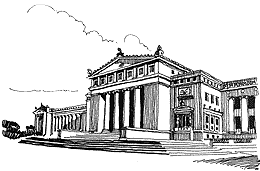Museum of Natural History
 At 775,000 square feet of floor area, the Field Museum is one of the largest museum buildings in the world. The collection originated with the World's Columbian Exposition in 1893, but only in 1906, when Marshall Field donated $8 million to the museum, could a permanent home be established. Architect Daniel Burnham (1846-1912) situated the museum in Grant Park as the eastern focal point of Congress Parkway as can be seen in the 1909 Plan of Chicago, but A. Montgomery Ward's suits to keep Grant Park free of buildings delayed construction. The bitter conflict was settled when Stanley Field persuaded the Illinois Central to donate two acres of lakefront landfill just south of (and now part of) Grant Park for the new museum. A symmetrical plan centers on the main pavilion, where entrances on north and south facades access a large central hall; exhibition spaces flank this hall, and continue in smaller, adjacent pavilions. The equally symmetrical facade is modelled on the Erechtheion, a 5th-century B.C. Greek temple. Fountains in the central hall, as well as glass partitions behind the giant entrance columns, were added by Harry Weese & Associates in 1977.
At 775,000 square feet of floor area, the Field Museum is one of the largest museum buildings in the world. The collection originated with the World's Columbian Exposition in 1893, but only in 1906, when Marshall Field donated $8 million to the museum, could a permanent home be established. Architect Daniel Burnham (1846-1912) situated the museum in Grant Park as the eastern focal point of Congress Parkway as can be seen in the 1909 Plan of Chicago, but A. Montgomery Ward's suits to keep Grant Park free of buildings delayed construction. The bitter conflict was settled when Stanley Field persuaded the Illinois Central to donate two acres of lakefront landfill just south of (and now part of) Grant Park for the new museum. A symmetrical plan centers on the main pavilion, where entrances on north and south facades access a large central hall; exhibition spaces flank this hall, and continue in smaller, adjacent pavilions. The equally symmetrical facade is modelled on the Erechtheion, a 5th-century B.C. Greek temple. Fountains in the central hall, as well as glass partitions behind the giant entrance columns, were added by Harry Weese & Associates in 1977.
Back to the Homepage
 At 775,000 square feet of floor area, the Field Museum is one of the largest museum buildings in the world. The collection originated with the World's Columbian Exposition in 1893, but only in 1906, when Marshall Field donated $8 million to the museum, could a permanent home be established. Architect Daniel Burnham (1846-1912) situated the museum in Grant Park as the eastern focal point of Congress Parkway as can be seen in the 1909 Plan of Chicago, but A. Montgomery Ward's suits to keep Grant Park free of buildings delayed construction. The bitter conflict was settled when Stanley Field persuaded the Illinois Central to donate two acres of lakefront landfill just south of (and now part of) Grant Park for the new museum. A symmetrical plan centers on the main pavilion, where entrances on north and south facades access a large central hall; exhibition spaces flank this hall, and continue in smaller, adjacent pavilions. The equally symmetrical facade is modelled on the Erechtheion, a 5th-century B.C. Greek temple. Fountains in the central hall, as well as glass partitions behind the giant entrance columns, were added by Harry Weese & Associates in 1977.
At 775,000 square feet of floor area, the Field Museum is one of the largest museum buildings in the world. The collection originated with the World's Columbian Exposition in 1893, but only in 1906, when Marshall Field donated $8 million to the museum, could a permanent home be established. Architect Daniel Burnham (1846-1912) situated the museum in Grant Park as the eastern focal point of Congress Parkway as can be seen in the 1909 Plan of Chicago, but A. Montgomery Ward's suits to keep Grant Park free of buildings delayed construction. The bitter conflict was settled when Stanley Field persuaded the Illinois Central to donate two acres of lakefront landfill just south of (and now part of) Grant Park for the new museum. A symmetrical plan centers on the main pavilion, where entrances on north and south facades access a large central hall; exhibition spaces flank this hall, and continue in smaller, adjacent pavilions. The equally symmetrical facade is modelled on the Erechtheion, a 5th-century B.C. Greek temple. Fountains in the central hall, as well as glass partitions behind the giant entrance columns, were added by Harry Weese & Associates in 1977.